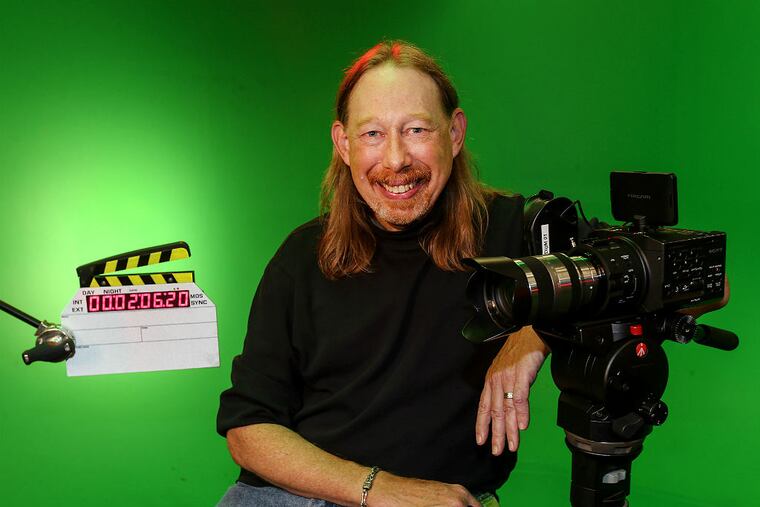Q&A: Drexel prof behind special effects for 'Jurassic Park,' 'Terminator 2'
John A. Berton teaches at Drexel University. But before he started clocking time at the Westphal College of Media Art and Design as an assistant professor of animation and visual effects, he hung out with dinosaurs and cyborgs.

John A. Berton teaches at Drexel University. But before he started clocking time at the Westphal College of Media Art and Design as an assistant professor of animation and visual effects, he hung out with dinosaurs and cyborgs.
Berton worked on the the visual effects teams for both Jurassic Park and Terminator 2: Judgment Day (the face-morphing effect? That's all Berton). Both movies receive sequels this summer - Jurassic World (Berton saw it the night before he was interviewed last week) and Terminator: Genisys, in theaters Wednesday. (In addition, he's worked on everything from The Mummy to Charlotte's Web to a 1997 rerelease of Star Wars.)
Berton talked to The Inquirer about why these sequels are coming out now, and about being "spellbound in the darkness."
This summer must be déjà vu for you.
It's been raining sequels from 20 years ago.
That's a specific time frame.
Well, it was a turning point for visual effects, it became something people knew about. People had been talking about special effects.
What's the difference?
Special effects are the things you do that are exterior to acting - explosions, rigs, stuntwork. Visual effects are done after the photography is finished - the paintings, the different kinds of light effects, the puppetry, and, in the modern era, optical printing and digital compositing. Those are done only to the picture, while special effects are done on the day of filming while you're shooting the movie. Terminator 2 and Jurassic Park particularly changed the ways people look at movies. It's when people realized the power of these effects.
But what is it about those two movies?
In Terminator 2, you have this character who can do things that nothing else can do and it's fundamental to the story. [Director] James Cameron did some effects in The Abyss, but if it didn't work, he could cut it. These movies allowed VFX teams to establish ourselves as fundamental to the storytelling process.
Terminator 2 comes out in 1991 and Jurassic Park in 1993. In three years, we go from a shiny metallic robot to all of a sudden you have dinosaurs. Dinosaurs have this terrific mythology, which I witnessed going to see Jurassic World. Here you have this mythology of the dinosaur and they are moving like you've never seen. You've seen stop motion or claymation, but these animals look like they have brains moving behind their eyes.
Filmmakers said, "This changes everything now. I can do anything." And that's a huge change.
Why is there an echo of these movies now?
There have been sequels for both Terminator and Jurassic Park, but they haven't rung the bell as much as the originals. When you have a turning point, people really go all in. But we've seen a reinvigoration of this idea. People have a chance to take a breath and reset. You've seen that with the JJ Abrams' Star Treks. They got a fresh breath with Jurassic World. There's a lot of homage to the first movie. It was a really, really nice film. People were cheering and having a great time. That's something I haven't seen in the movie theater for a long time. There's a lot of empty seats nowadays. But to see people cheering is a testament to the people who made Jurassic World.
I get that. I remember seeing "Jurassic Park" so vividly, to the point where I remember the seat I was sitting in and who I was sitting next to.
The former president of [visual effects house] Industrial Light & Magic, Jim Morris, who is the president of Pixar now, he would describe a certain type of person who is "spellbound in the darkness." That's me. The first movie I remember that turned me on to cinema was A Hard Day's Night and Help! in a double feature. Then there was James Bond. Dr. No was very imaginative filmmaking. Then I got turned on to sci-fi movies.
Jurassic Park and Terminator fit into this: It's making a movie that you can never see in reality. Dramas are great, documentaries are terrific, the human perspective you get from these movies is fantastic, but you can see it in the theater, you can see it in the street. But you can never see dinosaurs walk the Earth. The 1933 King Kong is what inspires me. If I could be half as clever as those guys with the tools I have now . . .?
For the filmmakers making Jurassic World, Jurassic Park is their inspiration for being in the business. They were 10 years old seeing this movie and now they're 30 years old making this movie.
215-854-5909
@mollyeichel